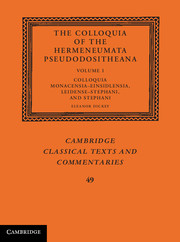Book contents
- Frontmatter
- Contents
- Plates
- Figures
- Acknowledgments
- Part One Introduction
- Part Two Colloquia Monacensia–Einsidlensia
- Commentary
- Part Three Colloquium Leidense–Stephani
- Introduction to the Colloquium Leidense–Stephani
- Text, Translation, and Critical Apparatus
- Commentary
- Part Four Colloquium Stephani
- Commentary
- Appendix
- Bibliography
- Concordances
Introduction to the Colloquium Leidense–Stephani
from Part Three - Colloquium Leidense–Stephani
Published online by Cambridge University Press: 05 May 2013
- Frontmatter
- Contents
- Plates
- Figures
- Acknowledgments
- Part One Introduction
- Part Two Colloquia Monacensia–Einsidlensia
- Commentary
- Part Three Colloquium Leidense–Stephani
- Introduction to the Colloquium Leidense–Stephani
- Text, Translation, and Critical Apparatus
- Commentary
- Part Four Colloquium Stephani
- Commentary
- Appendix
- Bibliography
- Concordances
Summary
Like the colloquia Monacensia–Einsidlensia, this work is often thought of as two separate entities. The primary witness to it is a ninth-century manuscript in Leiden, one of the earliest and most important sources for the Hermeneumata as a whole. The only other witness is the sixteenth-century edition published by Henri Estienne, which is based on two lost manuscripts. The Leiden manuscript is much to be preferred as a source where both are available, and this makes the edition largely useless for most of the Hermeneumata. For the colloquium, however, Estienne’s edition is indispensable, since the latter part of the colloquium text is missing from the manuscript: the edition is the only surviving source.
SOURCES FOR THE TEXT
The Leiden manuscript
The Leiden manuscript (L) is Leidensis Vossianus Gr. Q. 7, copied in the second quarter of the ninth century and currently housed in Leiden University Library (plate 12). It contains the colloquium at the very end of the Hermeneumata, on folios 37v–39r. The text in L breaks off at the end of section 8e; this is unlikely to have been the original end of the colloquium (see 3.1.2 below), but it must have been where the text ended in the exemplar from which L was copied, for the break comes in the midst of a page, with another text following on the same page. The manuscript is clearly written and generously spaced, with four columns per page and few abbreviations (apart from words for ‘and’, which are often abbreviated in both languages, and from the omission of nasals, which is marked with a horizontal line). The Greek, which occupies the left-hand column of each pair, is in Greek uncials; the Latin is in minuscule. In the colloquium (though not always in the rest of the manuscript) words are left undivided in both languages (when there is more than one word on a line), and the Greek has no diacritics.
- Type
- Chapter
- Information
- The Colloquia of the Hermeneumata Pseudodositheana , pp. 187 - 194Publisher: Cambridge University PressPrint publication year: 2012

